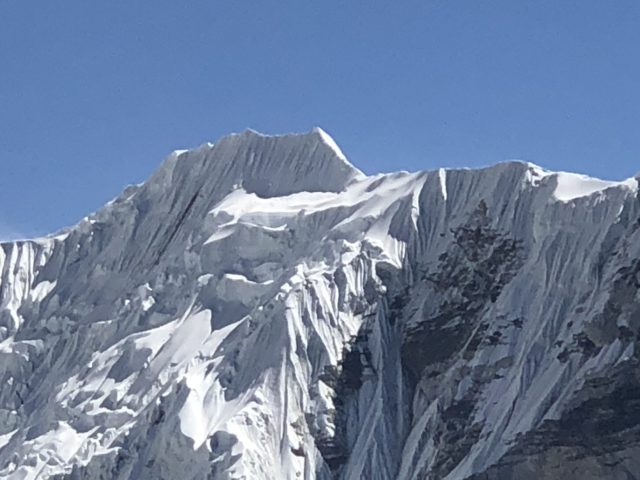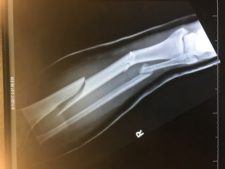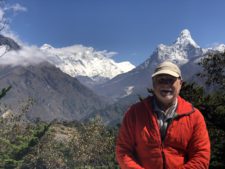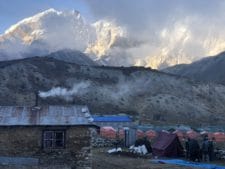My throat was so tight, I couldn’t swallow. My chest felt like it was exploding from the inside out. And with every step I took higher, the pain level increased. So, why in the world would I take another step towards the summit of Imja Tse aka Island Peak this Saturday in October 2018?
The Long Goodbye
One of the worst days of my life was in 2006 when I stood in my parent’s bedroom with my mom, Ida, standing in front of me. “Mom lets get a few things so you can spend the night.” She looked up at me through her strong, yet failing 79-year-old eyes. “I don’t want to leave my house.” She said clearly but softly in her southern drawl.
Jim, her husband of 58 years was in a nursing home a few miles away rehabbing from a stay in the hospital. His 88-year-old body fighting hard to continue to live.
While in the hospital, their primary care physician had delivered a two-punch blow to me: First, Dad was terminally ill with congestive heart failure and kidney disease and second that mom had Alzheimer’s and “There is nothing you can do about it.” He threw out over his shoulder as he briskly walked away.
With that, my mind began to process his words, the looks on my parent’s faces and what the future might hold.
Climbing with a Purpose
The next few years were a whirlwind with trips to Memphis, managing mom’s finances, paying bills and, most importantly helping Ida feel safe and loved. Then in August 2009 Alzheimer’s finally killed Ida That day I made a vow that she would not become another nameless statistic on the Alzheimer’s kill list.
My mountain climbing began late in life, at age 38, with a jaunt up Mont Blanc with a French guide who spoke about as much English as I did French. But we summited and I fell in love with the sport of mountaineering.
There was something about the sound of crampons crunching in the snowpack, being roped-up to a fellow climber, mutually dependent on each other to do the right thing. The wind turning my cheeks red, squinting as the morning sun cast new shadows across the hills. Yes, I can easily romanticize about the sport I love. But only a few days ago, I was questioning my judgment on Island Peak in Nepal.
The climb of Island was more than just another mountaineering quest for me, it was packed with multiple objectives and a quiet goal that would determine my climbing future.
Life’s Setbacks
On February 10, 2017, I was training with my regular partner, Jim Davidson, in Colorado for the 8000-meter peak Dhaulagiri in Nepal. We were on a simple 11,000-foot peak, Twin Sisters, outside of Estes Park. The winds were gusting strongly, but manageable until we crossed tree line. A sudden gust sent me cartwheeling into a rock field. Upon landing, I felt an excruciating pain in my lower right leg. I had broken my tibia and fibula in three places plus crushed my nasal cavity as I crashed into the unmoving rocks.
After multiple surgeries and a year of progress, I was uncertain of my mountaineering future. The injury left me with a lack of confidence, a significant setback to my physical fitness and an uncertainty if I would ever be comfortable at altitude again.
I knew I wasn’t ready to try to get back on the horse with an 8000er, but perhaps something smaller, more manageable would be wise, thus Island Peak at 20,320-feet.
Also, I had been asked by friends to investigate a potential dental clinic at the Kunde Hospital in a Himalayan village outside of Namche Bazaar. I was also tasked to look in a few Sherpa families using stoves donated by the Himalayan Stove Project.
Multiple Objectives
So with a lot on my mind, I left Denver for Kathmandu on October 2, 2018.
The flight was long as usual with my routing going through Singapore, making for a 30-hour trip. I arrived at Nepal’s Tribhuvan airport around 9:00 pm. As I stepped off the stairs from the airplane, a small smile emerged on my face. I felt the warm air with the high humidity and said to myself, “It feels good to be back.
I quickly found my bags and a taxi to the Hotel Tibet where I have stayed for years. The next day I was scheduled to go up with Kami Sherpa, my long-time friend whom we summited Everest, K2 plus two attempts on Lhotse. When the opportunity emerged to go to Nepal, I contacted Kami through his son Mingma if he was available to do some trekking and climb Island Peak with me. For me, it was more about keeping our relationship fresh and alive than needing a guide on a trek I’ve done seven times before. He said he wasn’t working anywhere else and was happy to go with me, thus the plan was set.
Unfortunately, a few days before I arrived in Nepal Kami had come down with gout so he stayed in Kathmandu a couple of days to recover and receive treatment. I flew to Lukla on Saturday, October 6 to meet up with Mingma, Kami son. We made the trek to Namche and visited the Kunde hospital verifying the need for a dental clinic. Walking the well-worn dirt trails brought back so many memories of my previous visits.
The Trek that will Change your Life
Kami caught up with me two days later and we continued our trek. Similar to my first visit in 1997, we went by way of Goyko and the Cho La pass rather than the traditional Everest Base Camp trail. As we visited the tiny and uncrowded villages of Dole and Machhermo, the scenery was stunning. I would highly recommend it for anyone looking to trek in the Khumbu but wanting to avoid the crowds.
We made a day hike to the top of Goyko Ri where at 17,600-feet we were rewarded with a view of Cho Oyu, Everest, Nuptse, Lhotse, and Makalu plus hundreds of other Himalayan peaks. Again, the experience was simply stunning.
The hike up Cho La pass was “interesting”. It starts with a steady, and somewhat steepish hike to a high plateau then drops into a wide valley before gaining steadily over rocks and boulders to the Pass proper. From here it drops onto a glacier then edges along it until once again drops in the flats to the village Dzongla. All in all a nice walk with a bit of altitude and scrambling. If it was icy or deep snow it would be a much more serious matter but thankfully for us, it was a clear, crisp dry event.
Kami and I continued our trek to the last village below Island Peak, Chhukung, a small outpost of a few lodges anchored by the Sunrise Lodge run by Mingma Sherpa. You can literally rent anything and everything you might need to climb Island. They offer boots, sleeping bags, crampons, ice axes, ropes packs, have down jackets – the works. He will outfit you for $100. They run the “Base Camp” where for 7,500 rupees, about US$65 you will have a nice tent with a solid sleeping pad, dinner, breakfast, and lunch plus clean water. Really, it’s quite the deal.
Island Peak
Kami and I took Mingma up on this offer and left for Basecamp early October 19. It was a cozy environment, clean with semi-permanent restrooms. My tent was spacious with a nice padded sleeping pad. Soon I found that Tendi Sherpa was also in camp so I went over to say hello. He is one of the up and coming elite Nepal guides who runs his own company TAGNepal plus works with Mike Hamill of Climbing the Seven Summits.
Off to bed at 6:00 pm and up at midnight. For breakfast, at midnight, I had a boiled egg, toast and coffee while Kami had Sampa
The climb began in the dark. For the next five hours, the route was lit by bright headlamps. Climbers were ahead and behind. Often we all switched places as those behind moved up and those ahead slowed down. For me, I learned from many expeditions years ago that climbing at this level is not a competition and you go at your own pace. I estimated there were over 50 people on the route this October day.
We reached crampon point about sunrise, perhaps a bit earlier as we left the rocks for the snow. Before I go on, the rocks were more than I had anticipated. As we left Base Camp, for half an hour it was a fairly level walk until we began to go higher, and higher and higher. The route followed rock walls cliffs, at times it was on narrow ledges. I cannot for the life of me understand why Nepal labels this a ”Trekking Peak” as it is full-on rock scrambling at altitude with all the risks. I think it sends the wrong message to prospective climbers.
Arriving at Crampon Point, we put on our harness, cows tails (a rigging of a carabiner and a jumar connected to the harness with webbing) and of course crampons. We left the point and continued to climb higher. Soon, about half an hour later, we navigated a series of deep crevasses, yet navigable, crossing that invited rappelling and climbing up the last one was a four ladder scenario that took us to the flat crossing to the base of the headwall. It was now early morning and the sun was warming the glacier on this clear day.

Lost in the Dark
A bit of introspection. About four hours from base camp, I began to feel dizzy, light headed. Not sure what was going on but it soon passed. A half an hour beyond crampon point, I began to stress to catch my breath.
Just short of the headwall, I began to doubt my capability to go higher. Again, some context. My last “big” summit was in 2014 on K2. I developed High Altitude Pulmonary Edema (HAPE) on the ascent and it was a difficult experience overall. Then in 2015, I attempted Lhotse but was stopped by the earthquake that took 9,000 Nepali lives that April. I returned to Nepal to once again attempt Lhotse in 2016, but similar to this year, as I approached Camp 2 at 21,500-feet, my lungs and throat constricted and I had extreme trouble breathing and ended my effort only reaching C2
With these recent experiences bouncing around my head plus the echoes of the Twin Sisters incident and a year of recovery, yes, my confidence was low. I knew this would be a test of my fitness, confidence, mental discipline and that if I needed help, I wouldn’t hesitate. Another thing I’ve learned in climbing for the past 25 years is that it’s silly to let pride stand in way of safety.
I used my Thuraya sat phone to call Diane, my wife. “I’m not OK. I love you.” We had established a protocol long ago that when I called and was cut-off quickly due to the vagaries of satellite phone communication, my status would be clear. Of course, it works better to start with “I’m OK, I love you.”
I continued to feel worse, short of breath, low energy. I wanted to turn back. We had left base camp at 1:00 am, reached High Camp around 3:00 am and Crampon Point at 5:00 am. While I wasn’t tired, leg weary or spent, I was short of breath. Every step higher was painful. At times my lungs felt like there was a 4th of July sparkler exploding inside, the base of my esophagus and trachea burned like acid was being poured on them. Each time I coughed and coughed hard, my abdomen exploded. It was painful yet I somehow knew I should not turn back.
Love and Support
With this conundrum, I called Jim Davidson, my trusted friend who had extreme experience plus knew me and my psyche well. “Jim, I need your help to think through this.” I explained what I was feeling, at 19,500’ what was left to get to the summit. “Jim, I really want to summit as this is my last big climb, but also I didn’t want to fall over.”
Jim then gave me the most salient advice I’ve ever received on a climb “Alan, climb at the pace your body will provide oxygen” And with that, I asked Kami to slow down and let me take the lead. Of course, he agreed and I was soon in front climbing step by step, jumar attached to the fixed rope. It was painful. I often coughed long, deep and hard creating a strong explosion and burning in my chest. I thought deeply about my purpose, “I was not hurting, I was hurt.” But deep inside I knew I needed, “needed” to make the summit.
The Push
The last 18 months had been complicated in my life with respect to climbing. The broken leg, the recovery, the lost dreams of more 8000ers. And the last 18 months had been a joy, marrying Diane, creating a new home and family, extending my speaking writing and coaching business to new levels. Yes, so much was good yet it was climbing that fed my soul.
I reached the two-thirds mark on the headwall. It was laborious and painful. The slope was 40 to 60 degrees, it had nothing to do with trekking. It was similar to the Lhotse Face without steps. At the time, I pulled hard on the jumar. My crampons dug in.
I thought about why I was climbing, my purpose and asked myself these questions as I made the last push: “Am I hurt or hurting”, “Is this hard or impossible” and “What is the one reason to go on and not turn back”. The answer to all of these was Ida.
I was climbing Island Peak as a continuation of my effort to raise money for Alzheimer’s research. Alzheimer’s killed my mom, Ida in 2009 and I have been steadfast to use what many consider a selfish sport to raise awareness that the disease has no prevention, cure or reversal and is 100% deadly.
As the morning developed and the crowds grew on this popular climb, in the spirit of “misery loves company” I saw a few people struggling as I was. I began to take a step and count breaths, something I’ve never done, even on 8000-meter peaks. Suddenly, my breathing came back under control, the pain lessened and I felt a surge of confidence. This was similar to my K2 experience. I pushed on nearing the summit ridge. And then we were there.
The final ramp to the tiny summit was like a staircase, perhaps only 10 meters long at a 20-degree angle. I walked up it with ease – surprising myself and creating an entirely new set of questions within my self-confidence crisis.
Summit
Kami and I stood together on the summit. We shared it with a rather large group of about 10 from various countries. Smartphones, selfie-sticks and a few old-fashion cameras were hauled out, asking one another “Will you take our picture?” Apparently, Kami appeared to be most in control and became the cameraman for almost everyone there. In the midst of this, he grabbed my camera, gave it to another Sherpa and said: “Take us.” I smiled deeply inside that my friend wanted our picture together on the summit.
I stepped aside from the crowd, albeit not far as the summit was the size of a large dining room table. I looked around as the winds were now gusting to from 25 to 20 mph, but it was not uncomfortable as I took in the view. I feel relieved and pleased.
We quickly down climbed and soon reached crampon point. And then something occurred that surprised me. As I was taking off my crampons and harness, Kami leaned over and extend his hand. We shook hands and then he went further and gave me an old-fashion hug and simply said “Good job.”
Kami and I have been through a lot. Summiting Everest was a great experience. I did well and felt fine. K2 was good until the summit push. I give Kami full credit for my summit and safe return. The Lhotse experiences were exercises in high-altitude mountaineering but brought us even closer. After the 2015 earthquake, I raised money to help Kami rebuild his house and again when he was injured on K2 in 2015 (I was not there). I know and love his family. They are my Nepal family as Diane and I are their US family. But this sign of affection, appreciation, and respect touched me as few things have.
As we down climbed the rock sections and in the light of day, I realized what we had done. While not overly technical nor difficult, it was more than “trekking”. We soon reached Base Camp, rested for an hour then made the three-hour trek back Chhukung. I was coughing the entire way, but my lungs no longer felt on fire.
I made the decision as we walked that I needed to get lower fast and when we arrived in Chhukung arranged for a helicopter the next morning to take me to Lukla. I then went on to Kathmandu and flew out that same night to the U.S. I was home 48 hours after summiting Island Peak.
Postscript
Now that I’m back home for a few days, my lungs feel better. I went to the doc and she suggests that I may have residual scar tissue from the HAPE that is aggravated at altitude. This is similar to my own self-diagnosis. In order to confirm this, I would need to have a CAT Scan and tests done in a hyperbaric chamber to measure my lung functions at low levels of oxygen.
All I know that now at age 62, I’m proud of what this Memphis Boy has achieved in the world of high-altitude climbing. I don’t need to go through the list. I know it. And it feels good looking back. And, there is a desire deep inside to keep going. Yet I know, I know what I know. One of the deeply personal questions for this trip was “Do I have anything left?”
Climb On!
Alan
Memories are Everything
Cure Alzheimer’s Fund – $38,020!! only $1,980 away from reaching $40,000 in total!!!!
Thank you everyone who donated to the Cure Alzheimer’s Fund during this climb. The campaign end son 31 October so a day or so to contribute.
Jim and Carol Beers will match all the donations to $20,000 to theCure Alzheimer’s Fund and we are only $1,980 away from reaching $40,000 in total!!!!
I’ve worked with the CAF since 2008 finding their research model both effective and efficient. All of their overhead is underwritten by their founders so that 100% of all donations go directly to fund research projects. Since it’s founding, the CAF has funded more than $74,000,000 to 337 research project. Their funded initiatives have been responsible for several key breakthroughs—including a potential treatment selected by the National Institutes of Health (NIH) for its elite “Blueprint” drug discovery program, and the ground-breaking “Alzheimer’s in a Dish” study, which promises to greatly accelerate drug testing and was reported by the New York Times as a “giant step forward”. Charity Navigator scored the CAF with 100 percent regarding its overall financial health.
You can take us over the top at our Crowd Rise fundraising site






















10 thoughts on “Island Peak 2018: A Push to the Top and the End”
Alan – thanks for your inspiration. You do help me keep going even though I have different challenges.
I’ve been dealing with grief since my mother died and I admire your fight more than I can adequately express.
I’m so sorry for the loss your mother Sharon. I climb for her, Ida and millions more.
Alan, love the countrywide photo of Ama Dablam. How can I get a copy that I could enlarge for possible framing? Thank you.
Send me an email and we can discuss offline.
Alan – if there are one r two I would like, may I also email you?
Congrats on your achievements. I never doubted you would succeed.
To what email address?
Alan, you’re an inspiration. Thanks for all you do, and your willingness to share
“Life brings sorrows and joys alike. It is what a man does with them — not what they do to him — that is the true test of his mettle.”
— Theodore Roosevelt
This is Alan to a “T”.
Congratulations! As always, so enjoyed reading your posts, but today especially as it’s my 69th birthday. Using a southern term, I’m a “youngun” ….. ?
As always, I enjoy your posts – thoughts, goals, challenges and successes!!
Great job, Alan … and an interesting and well-written narrative, as usual! Thank you for all you do!
Comments are closed.